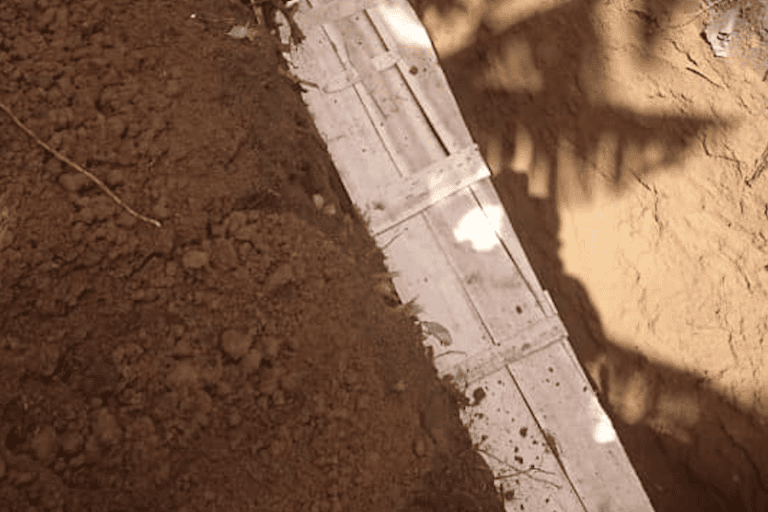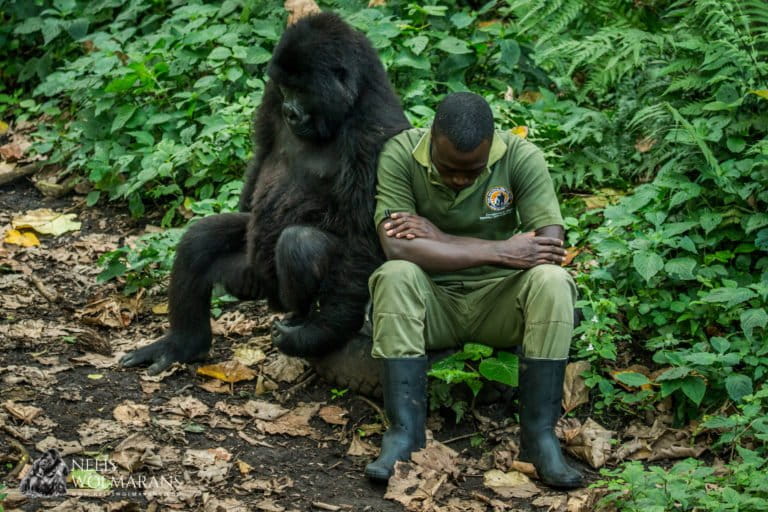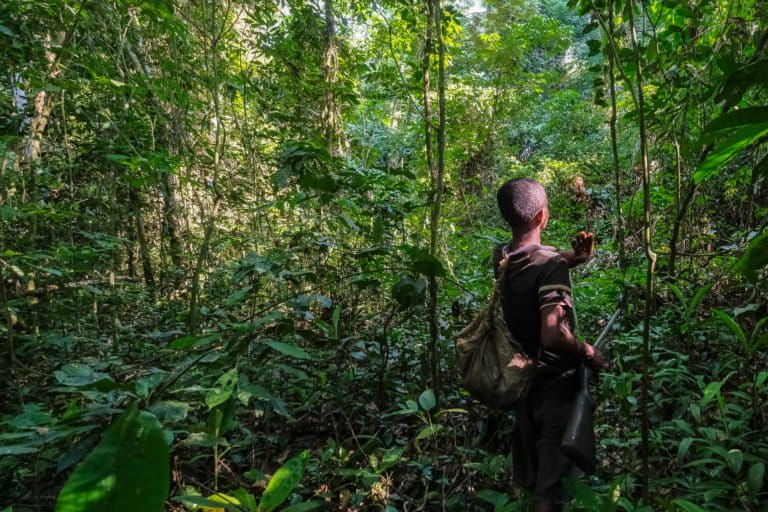- The Coercive Conservation paradigm prevents local communities from accessing their lands, leading to human rights abuses, corrupt resource extraction, and loss of habitat and wildlife.
- Kahuzi Biega National Park in the Democratic Republic of the Congo, which expelled Indigenous Batwa people in 1975, is now overrun by refugees, militias, and mining, while ecoguards reportedly burn villages and kill indigenous people.
- We can transform conservation by supporting Protected Areas that integrate human well-being, are designed and managed by local communities, and are protected by local people with support from security forces, upon request.
- This article is a commentary. The views expressed are those of the author, not necessarily of Mongabay.
A chief from the Bakanga clan of Batwa living within view of Mount Kahuzi was asked in the 1970s to help delineate a boundary using surveyor’s chains. He agreed, not knowing that he was being made to participate in sealing his own fate. According to his son, by the time he understood what was happening, it was too late: He and his community had been excluded from the forest they had lived in and protected for thousands of years.
The last century of conservation was based on the underlying belief that people and nature do not mix; thus protecting nature required preventing local communities from accessing their lands. Today, this paradigm is increasingly referred to as ‘Fortress’, ‘Coercive’, ‘Militarized’ or ‘Colonial’ conservation. Though initially motivated by an admirable commitment to protecting nature and biodiversity, this mindset meant that decisions around the establishment and management of protected areas were typically imposed by outsiders—often at gunpoint.

In reality, the expulsion of traditional owners and inhabitants has frequently had the opposite of intended effect. It opens the so-called Protected Areas to an influx of outsiders, handing control over to elites who can then establish relationships with militias and other resource exploiters. This pattern has played out globally, and Kahuzi Biega National Park is no exception; it is filled with people: ecoguards, tourists, refugees, poachers, miners, loggers and militias. Not surprisingly, declines in wildlife populations have been recorded for several key protected species since the area was ‘protected’, according to UNESCO.
The 2021 conference Our Land Our Nature featured speakers from around the world, explaining the dire impacts of the Coercive Conservation approach on the people it displaces. Moreover, numerous studies demonstrate that the traditional land rights holders are often better able to protect the landscape and biodiversity. The Coercive Conservation paradigm all but guarantees that there will be a crisis of biodiversity loss, human cultural diversity loss, and loss of sustainable lifeways.
Violence against the oldest living human culture
The Batwa people, previously known as Pygmies, are believed to represent the oldest living human culture in the Congo Basin. The 1975 expansion of the nature reserve, created in 1937 by the Belgian colonial government, expelled an estimated 6,000 Batwa to create Kahuzi Biega National Park in Zaire (now the Democratic Republic of the Congo, or DRC).
No longer allowed to live, hunt, perform rituals or worship at sacred sites inside the Park boundary, the Bakanga clan and others like them became landless refugees. Their loss was enshrined in 1980 when the Park was designated a World Heritage Site by UNESCO. Largely rejected by neighboring Bantu tribes once they were landless, and thus unable to integrate into traditional governance systems or the agricultural economy, the Batwa have lived in abject poverty and social breakdown for the past 45 years.

Seeking to address these historical injustices, several international NGOs brought representatives of the Batwa people living around the Park into a series of dialogues with Park administrators in 2014. Key negotiating points were the provision of alternative lands for the Batwa, as well as access to education and basic economic resources.
Though several agreements were reached, none was ever implemented by the Congolese government. In late 2018, out of options for survival, a number of Batwa families moved back into their ancestral homelands within the Park.
Three years later, levels of violence in and around the Park are rising. In October 2021, Initiative for Equality‘s regional network (RIFE) in DRC, Rwanda and Burundi released a preliminary report detailing killings, village burnings, arbitrary arrests and other rights violations that had been brought to our attention over the past 5 years. The updated report provides what is probably an underestimate of the abuses perpetrated both by Kahuzi Biega National Park staff and by members of the Congolese army:
- 29 Batwa killed by ecoguards and/or soldiers;
- 16 Batwa wounded or threatened with killing (shot at with guns, etc.)
- 12 villages burned (some were burned twice; Buhoyi village was burned three times)
- Large numbers of displaced families, some displaced repeatedly
- 17 arbitrary arrests and detentions in prison; 14 were later released when lawyers intervened, 2 died due to poor prison conditions, and one (Chief Douze of Buhoyi) remains in jail on what are widely viewed as political charges
The most recent killings, including two Batwa children burned in their homes at Bugamanda village in November of 2021, have not been covered by the news media in DRC, let alone elsewhere.

There is an urgent need for methodical monitoring and incident reports on the ground, and for substantial investigations into each of the incidents. However, a lack of political will by authorities, and the difficulty and danger of travel in these areas, poses a significant challenge to monitoring efforts.
A tragedy in three acts
Facing violence and crisis, it is natural to want to blame rogue actors, crack down on individual perpetrators, and declare the problem solved. But the problems in Kahuzi Biega (as in many Protected Areas around the world) are systemic, stemming from three underlying pathologies that must be addressed.
The first act in this tragedy was the expulsion of the Batwa from their homelands. They knew every hill and valley, and were deeply motivated to protect the forest which encompassed their sacred sites and totem animals. In their place, the Park hired ecoguards who are vastly less knowledgeable and less motivated to protect the Park. Moreover, their expulsion turned the Batwa into a poverty-stricken underclass, facilitating their exploitation. This exploitation takes a variety of forms – for example being hired by profiteers who prefer someone else to do their illegal “dirty work” such as making charcoal or digging for minerals in the Park.
In other cases, Park officials have purchased the allegiance of individual Batwa to spy on their community (according to witnesses in a recent court case), put out false statements, or participate in sham ceremonies for purposes of public relations. The Batwa are used as scapegoats when illicit activities are discovered in the Park. Allegations against Park officials or ecoguards are deflected onto the Batwa, who are accused of being petty criminals or malicious destroyers of nature. And if Batwa are killed, they are blamed for serving as “human shields” for the militias described below.

The second horrific act in this tragedy was the aftermath of the Rwandan genocide, which sent hundreds of thousands of refugees fleeing into eastern DRC. A regional war in the late 1990s and early 2000s, which involved Rwandan, Ugandan and Congolese armed forces and irregular militias, strongly impacted the Kahuzi Biega region. During that period, according to an eyewitness who lived there at the time, Interahamwe and other militias and regular armies moved through or hid in the Park, raping women and kidnapping men into their service.
In fact, parts of the Park are still an active conflict zone: Hutu refugees and their militias (FDLR, CNRD and Nyatura) are operating in the Park, especially around a sizeable mine site at Katasomwa. The local ethnic Tembo community has formed a self-defense militia called Raia Mutomboki which fights the Hutu militias for control of mining sites, with the Congolese army (FARDC) periodically taking sides.
The final tragedy is corruption, which is famously rampant in the DRC; the Protected Areas system is no exception. Then-President Joseph Kabila appointed Rev. Cosma Wilungula as Director General of the ICCN(Congolese Institute for Nature Conservation) in August 2005, the same month Wilungula stepped down as Chairman of the Board of Directors of one of DRC’s biggest mining companies, AngloGold Ashanti Kilo, and Director General of the Office des Mines d’Or de Kilo-Moto (OKIMO) in Ituri Province.
In April 2005, Human Rights Watch (HRW) published a lengthy report on the abusive, corrupt and lucrative relationship between AngloGold Ashanti Kilo, OKIMO, and the violent militias operating in the region – particularly the “FNI armed group”.

HRW notes that “OKIMO has exclusive mining rights to a zone of 83,000 square kilometers, an area three times the size of Belgium”. Many contracts were signed by Wilungula on behalf of OKIMO and AngloGold Ashanti Kilo during the time period covered by the HRW report.
From this unsavory position, Rev. Wilungula stepped directly into his post overseeing Kahuzi Biega and Virunga National Parks, both in mineral-rich conflict zones, at the request of Joseph Kabila. Kabila’s family is the subject of many investigations into corrupt business practices and illicit off-shoring of profits, and is known to own at least 80 businesses in DRC.
In June 2021, the UN Security Council’s “Group of Experts on the DRC” issued a report on arms traffickingbetween the ICCN – under Rev. Wilungula – and the FARDC at Virunga National Park. On August 3, 2021, the Congolese Minister of the Environment suspended Wilungula and his entire Board of Directors at the ICCN while a corruption investigation proceeded under the new President, Felix Tshisekedi. Wilungula then resigned on August 24, 2021, and has not resurfaced in the news.
Meanwhile, over 200 NGOs have issued a call to stop resource exploitation in the DRC’s Protected Areas, and a group of Batwa have accused Kahuzi Biega National Park Director De Dieu Bya’ombe of illicit timber harvesting in the Park. According to the Batwa statement on June 1, 2020, officials at the Park were deploying sawyers at four sites, bringing the wood to the Park headquarters at Tshivanga and then transporting it by truck to the large city of Bukavu.
To date, no independent inquiry has released any statement on this matter.
While it is not out of the question that underpaid ecoguards could accept kick-backs from those exploiting resources in the Park, the larger question is the nature of the relationship between Park officials and the militias and mine sites around Katasomwa.

Given the track record of higher-ups like Rev. Wilungula, the question of whether illicit relationships exist at the level of park management would seem to be critically important to investigate.
Transitioning to a new paradigm
The good news is that much of this damage can be reversed – provided we change our approach to conservation before any more species are lost or human communities destroyed. A new paradigm, based in the belief that people and nature can re-learn to live together, will allow us to work towards a conservation that is designed and implemented by Indigenous peoples and local communities, with advice (not demands) from experts. It must integrate human well-being with the survival of the landscape, ecology, and biodiversity, and must not overwhelm ecosystems and local communities with the impacts of visitors. Finally, it should be monitored and protected (from militias, invasions, poaching and illicit resource extraction) by the local people – with support by security forces upon request.
Key recommendations for a successful transition include the following.
The landscapes, communities and problems at Kahuzi Biega need to be carefully assessed through community mapping and negotiation of traditional land rights. There also needs to be an accurate documentation of the social, economic and cultural destruction of the Batwa people and a thorough assessment of illicit natural resource extraction, corruption, human settlements, and armed conflict in the Park.
A sincere Truth and Reconciliation process is needed, to acknowledge and make reparations for the harms done. Spiritual leaders from the local Batwa and Bantu communities should play a leading role. Further, any such process must not preempt legal charges against those who ordered or engaged in serious crimes against humanity or against nature.

A management plan for the region must be developed, with the traditional land rights holders making decisions supported by a team of expert ecologists, foresters, conservationists, endangered species biologists, anthropologists, development specialists, conflict specialists and others who can help the local people to restore the ecosystems and their societies, and forge a peaceful coexistence.
The legal status of the protected lands must be changed to reflect the rights of the Indigenous peoples and local communities, as well as the worthy conservation objectives.
Courage, Leadership and Transformation
The steps proposed above are reasonable and indeed necessary to facilitate effective conservation at Kahuzi Biega. Yet they may seem shocking as they represent a profound departure from current practices at the Park. It will take real courage and leadership to move in this new direction.
Government agencies, donors and NGOs that have long operated under the outdated conservation paradigm need to step up to this challenge, or risk their laudable goals being overshadowed by violence and displacement, or confounded by corruption and mismanagement. To succeed, we must embrace a paradigm which understands that the protection of nature is integrally tied to the well-being of human societies. Without this kind of genuine transformation, the conflict will continue.
Last November, two Indigenous Batwa men slipped through the forest, protected by their sacred walking stick and deep forest knowledge, which prevented them from being seen by their armed attackers. Some four days after their village was burned, after hiking for more than 20 kilometers (12½ miles) through the mountainous terrain, they finally managed to reach another village. They put their lives at great risk to call on us, the outside world, for help.
If we can respond with the same courage that these Batwa men demonstrated, we can transform the tragedy at Kahuzi Biega into a peaceful coexistence between peoples and nature.

Deborah S. Rogers is an interdisciplinary scientist and advocate, with degrees in evolutionary biology (BA), ecology (MS) and cultural evolution (PhD). After working in conservation and environmental monitoring, she currently serves as President of Initiative for Equality, a global network of organizations addressing social, economic and political inequalities.
Banner image: Park rangers carrying out an anti-poaching patrol in Kahuzi-Biega National Park in the DRC. Image courtesy of A.J.Plumptre for WCS.
Related listening from Mongabay’s podcast: A conversation with Victoria Tauli-Corpuz and Zack Romo about Indigenous rights and the future of biodiversity conservation. Listen here:
FEEDBACK: Use this form to send a message to the author of this post. If you want to post a public comment, you can do that at the bottom of the page.
